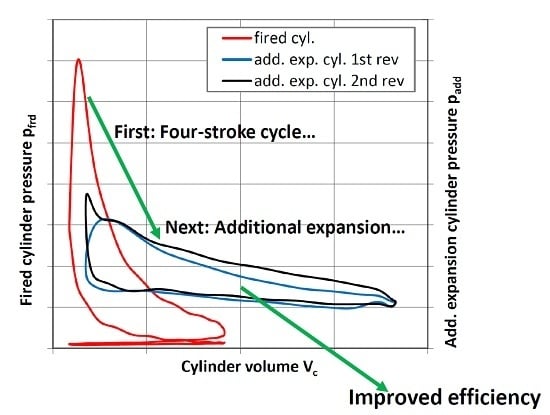Selected Issues of the Indicating Measurements in a Spark Ignition Engine with an Additional Expansion Process
Abstract
:1. Introduction
Five-Stroke Engine Developed at Cracow University of Technology
2. Materials and Methods
2.1. Background
2.2. Purpose of the Work
2.3. Specific Features of the Test Engine
2.4. The Test Stand
2.5. Methodology for Measurement of the In-Cylinder Pressure
3. Results
3.1. Range of the Implemented Research
3.2. Measurements of the In-Cylinder Pressure of the Tested Engine
3.3. Brake Specific Fuel Consumption and Effective Power
3.4. Mechanical Efficiency of the Tested Engine
4. Discussion
- During the tests, significant differences in the maximum pressure in the two cylinders of additional expansion were observed. These differences arise from the small area of the cross-section of the passage between the cylinders. This is a limitation of the base engine. In the developed engine, there are two smaller cylinders of additional expansion instead of one larger cylinder. Improvement of the existing motor can consist only of a larger cross-section of the channel, which connects the cylinders of additional expansion.
- The energy recovery ratio—the indicated power of the additional expansion cylinders—is up to 12.6% of the indicated power of the fired cylinders. Obstacles to achieving better results were: high volume of the transfer ports between the fired cylinders and additional expansion cylinder, as well as the unchanged volume of the former combustion chambers in the cylinders of additional expansion, and also the division of the additional expansion volume into two cylinders. Kéromnès et al. showed a significantly higher ratio of the indicated work of the additional expansion cylinder to the indicated work of the fired cylinder. They obtained a value of about 18%—[14] (p. 265).
- During the engine testing, a high value of load was obtained, from which the cylinders of additional expansion of the engine gave power to the output. This was about 60 Nm and was caused by the limitations of the above-mentioned structure of the base engine, mainly from the loss of energy in the parasitic volumes. Below 60 Nm of torque, the engine still operates at a relatively low BSFC, but is related to the effect of downsizing, instead of the additional effects of the second expansion of exhaust gas. This aspect of the five-stroke engine was not strongly emphasized in [14]. The problem of the selection of an appropriate displacement volume of the second expansion cylinder linked to this issue was analyzed by Li et al. in [18].
- This research revealed an additional problem, which was not described in the work content; the increased consumption of oil lubricating the engine when working with low load. The increased consumption of lubricating oil is caused by the occurrence of negative pressure in the inlet channel of the turbine at the opening of the exhaust valves of the engine. This significantly changes the operation of an oil seal of the turbocharger rotor shaft and the sucking of oil into the exhaust system occurs.
- The maximum values of the mechanical efficiency of the engine achieved by the author correspond to the results presented in [14]. This indicates a good level of technical modification made to the engine.
- The minimum brake specific fuel consumption amounted to 240 g/kWh. One should remember that the tested engine worked with all the equipment necessary for autonomous operation, i.e., with the alternator, oil pump, coolant pump, and the high pressure fuel pump. A low-pressure fuel pump was also supplied from the engine power grid. Kéromnès et al. obtained a BSFC of 226.4 g/kWh, but the engine was working without propelling an oil pump and a water pump, and probably also without the alternator. A drive of these devices by the engine undoubtedly caused an increase in the brake specific fuel consumption.
- Simulations to optimize the valve timing of the tested engine, or the development of new camshafts. The current valve timing is based on four-stroke engine settings and is not optimized for the new engine with a significantly different design and performance.
- An enlargement of the crossover passage between the additional expansion cylinders, and a reduction of the parasitic volume of the second expansion cylinders by the use of modified pistons, since it is the only modification to the combustion chambers of the cylinders of additional expansion that is possible to make in the developed engine.
- Selection of a turbocharger more matched to the specific parameters of the engine with the additional expansion of the exhaust gas. The plan is to apply a different turbocharger controlled by the wastegate valve. The initial analysis of this issue indicated that a VNT-turbocharger may not be suitable for the tested engine.
- Changing the method of control of the high fuel pressure—a pressure relief valve is currently used, which introduces a loss of power to the system. the plan is to develop a pressure control system by varying the flow rate of the high-pressure pump, similar to the base engine. This action requires the development of a separate electronic controller, because the used stand-alone engine management system does not offer such feasibility.
- After improving the engine, emissions testing will be carried out and selection of the aftertreatment system will be made, taking into consideration the specificity of the engine.
5. Conclusions
- The results obtained by the author are so promising that despite the significant limitations in the feasibility of developing the design resulting from the adoption of a mass-produced four-cylinder engine as a base, he intends to lead its further development.
- The engine developed according to the concept of the five-stroke engine has many advantages, especially if it is designed from scratch, but it also has some drawbacks that make it not quite suitable for use in the classical drive system of cars. At low loads, there are some problems, such as the expansion of the exhaust gas below the ambient pressure, which results in energy loss, or problems with the operation of the turbocharger.
- Under heavy load, the engine achieves high efficiency while maintaining a high power-to-weight ratio. This makes this type of engine very well suited for applications where would it work with average high load, that is, for example, as a stationary electric generator or as an engine for the hybrid powertrain of a motor vehicle, in particular in series arrangement, but also under certain conditions for a power-split hybrid. A similar application field for such an engine is also indicated by the authors of study [14], who developed the five-stroke engine as the main power source for an extended-range electric vehicle or for a series-hybrid arrangement.
Acknowledgments
Conflicts of Interest
References
- Ota, Y.; Ito, Y.; Kawamura, A.; Nishiura, H.; Matsuo, S. Fuel Economy Improvement Technologies of the ESTEC 2ZR-FXE Engine. Toyota Tech. Rev. 2016, 10, 54–59. [Google Scholar]
- European Commission. Horizon 2020 Work Programme 2016–2017 Smart, Green and Integrated Transport. Available online: https://ec.europa.eu/research/participants/data/ref/h2020/wp/2016_2017/main/h2020-wp1617-transport_en.pdf (accessed on 27 December 2016).
- Merkisz, J.; Fuć, P.; Lijewski, P.; Ziółkowski, A.; Galant, M.; Siedlecki, M. Analysis of an Increase in the Efficiency of a Spark Ignition Engine Through the Application of an Automotive Thermoelectric Generator. J. Electron. Mater. 2016, 45, 4028–4037. [Google Scholar] [CrossRef]
- Mendera, K. Deliberations on thermodynamic cycle of the engine with extended expansion. In Proceedings of the KONMOT ’76 Automotive Conference, Krakow, Poland, 20–23 April 1976; pp. 253–263. (In Polish)
- Noga, M.; Sendyka, B. Determination of the theorethical and total efficiency of the five-stroke SI engine. Int. J. Automot. Technol. 2014, 15, 1083–1089. [Google Scholar] [CrossRef]
- Cummins, C.L. Internal Fire, 3rd ed.; Carnot Press: Wilsonville, OR, USA, 2000; pp. 219–223. [Google Scholar]
- Miller, R.H. Supercharging and internal cooling cycle for high output. ASME Trans. 1947, 69, 453–464. [Google Scholar]
- Goto, T.; Hatamura, K.; Takizawa, S.; Hayama, N.; Abe, H.; Kanesaka, H. Development of V6 Miller Cycle Gasoline Engine; SAE Technical Paper 940198; SAE International: Warrendale, PA, USA, 1994. [Google Scholar]
- Malcev, V.; Bozhenov, A.; Schwab, R.; Müther, M. High Power Density High Speed Diesel. MTZ Ind. 2016, 2, 14–21. [Google Scholar] [CrossRef]
- Harada, S.; Shinagawa, T.; Kondo, T.; Togawa, K.; Kudo, M.; Matsubara, W. The New Toyota 1.2-Liter Inline 4-Cylinder ESTEC D-4T Engine. Toyota Tech. Rev. 2016, 10, 54–59. [Google Scholar]
- Grab-Rogaliński, K.; Szwaja, S. Influence of Intake Valve Closure Angle on IC Engine Indicated Parameters. J. KONES 2015, 22, 29–35. [Google Scholar]
- Pielecha, I.; Czajka, J.; Borowski, P.; Wisłocki, K. Thermodynamic indexes of Atkinson cycle combustion engine operation under transient conditions. Combust. Engines 2013, 154, 517–524. [Google Scholar]
- Schmitz, G. Five-Stroke Internal Combustion Engine. U.S. Patent 6553977, 29 April 2003. Available online: http://www.google.com/patents/US6553977 (accessed on 27 December 2016). [Google Scholar]
- Kéromnès, A.; Delaporte, B.; Schmitz, G.; Le Moyne, L. Development and validation of a 5 stroke engine for range extenders application. Energy Convers. Manag. 2014, 82, 259–267. [Google Scholar] [CrossRef]
- Krebs, R.; Böhme, J.; Dornhöfer, R.; Wurms, R.; Friedmann, K.; Helbig, J.; Hatz, W. The new Audi 2.0T FSI engine—The first direct injection turbo gasoline engine from Audi. In Proceedings of the 25th International Vienna Motor Symposium, Vienna, Austria, 29–30 April 2004; VDI-Verlag: Düsseldorf, Germany, 2004; pp. 224–246. [Google Scholar]
- Noga, M.; Sendyka, B. New design of the five stroke SI engine. J. KONES 2013, 20, 239–246. [Google Scholar] [CrossRef]
- Noga, M.; Sendyka, B. Increase of efficiency of SI engine through the implementation of thermodynamic cycle with additional expansion. Bull. Pol. Acad. Sci. Tech. Sci. 2014, 62, 349–355. [Google Scholar] [CrossRef]
- Li, T.; Zheng, B.; Yin, T. Fuel conversion efficiency improvements in a highly boosted spark-ignition engine with ultra-expansion cycle. Energy Convers. Manag. 2015, 103, 448–458. [Google Scholar] [CrossRef]
- Li, T.; Wang, B.; Zheng, B. A comparison between Miller and five-stroke cycles for enabling deeply downsized, highly boosted, spark-ignition engines with ultra expansion. Energy Convers. Manag. 2016, 123, 140–152. [Google Scholar] [CrossRef]
- Palanivendhan, M.; Modi, H.; Bansal, G. Five Stroke Internal Combustion Engine. Int. J. Control Theory Appl. 2016, 13, 5855–5862. [Google Scholar]
- Wlodarczyk, M.T. Fiber optic-based in-cylinder pressure sensor for advanced engine control and monitoring. Combust. Engines 2012, 151, 3–8. [Google Scholar]
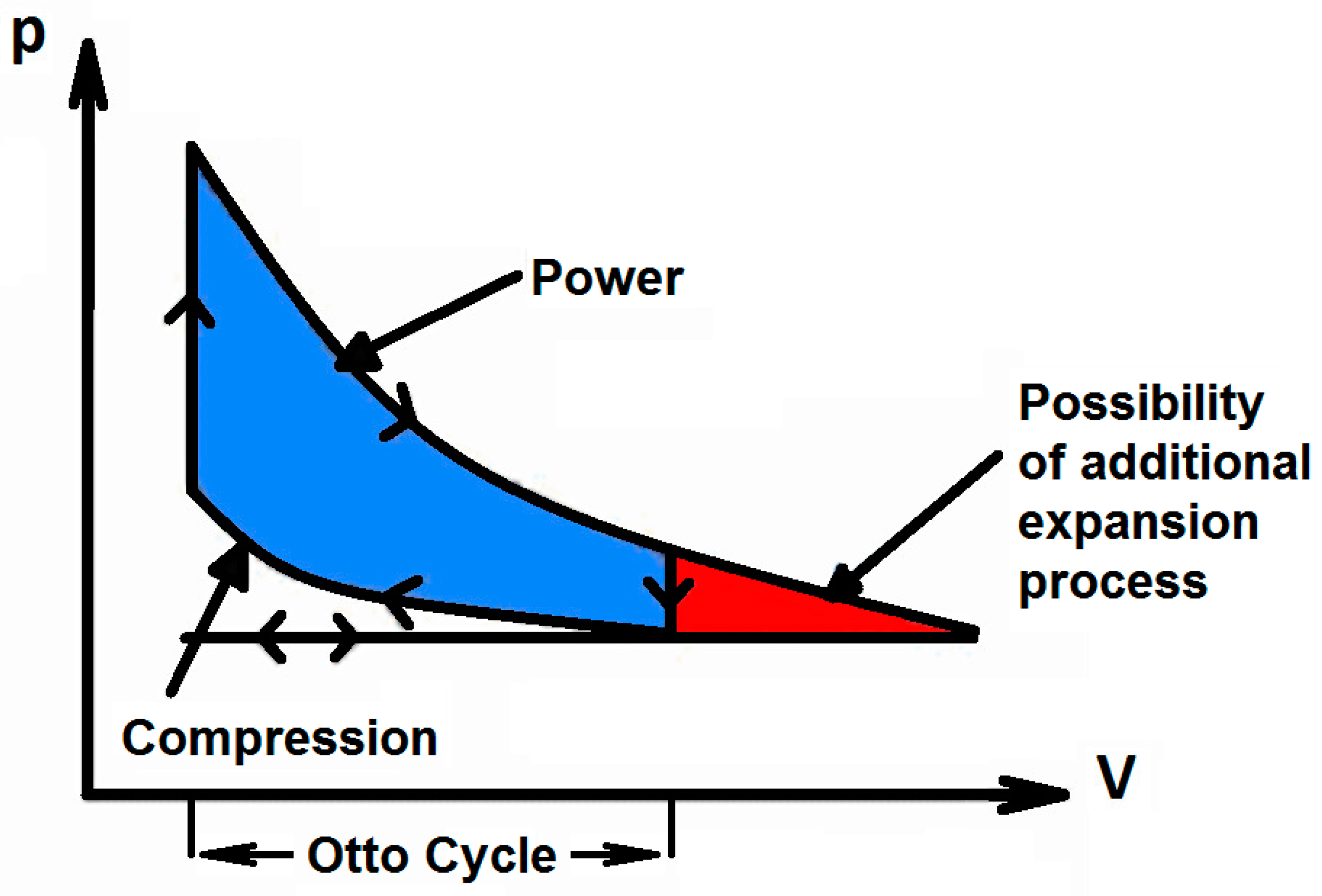
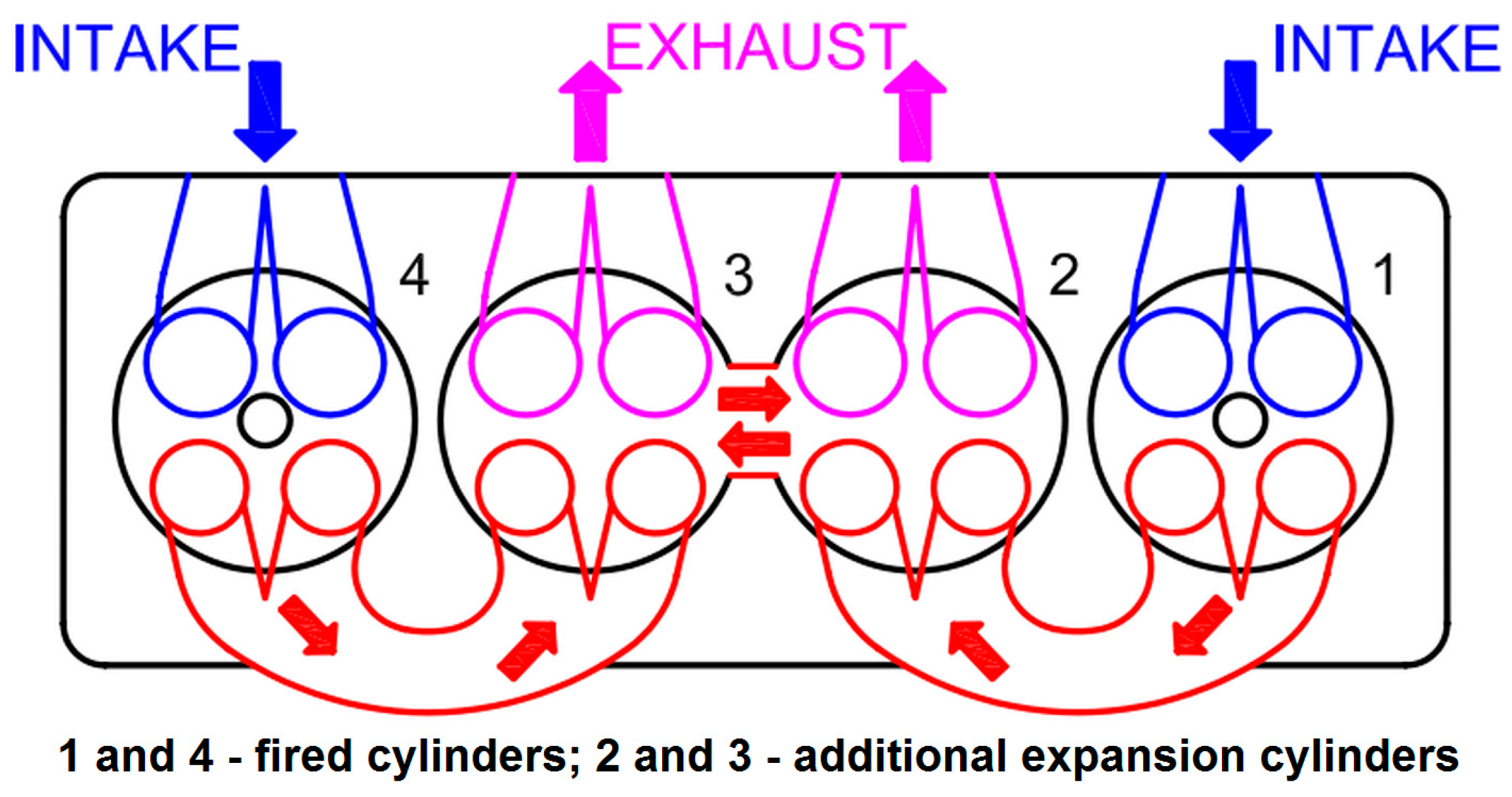
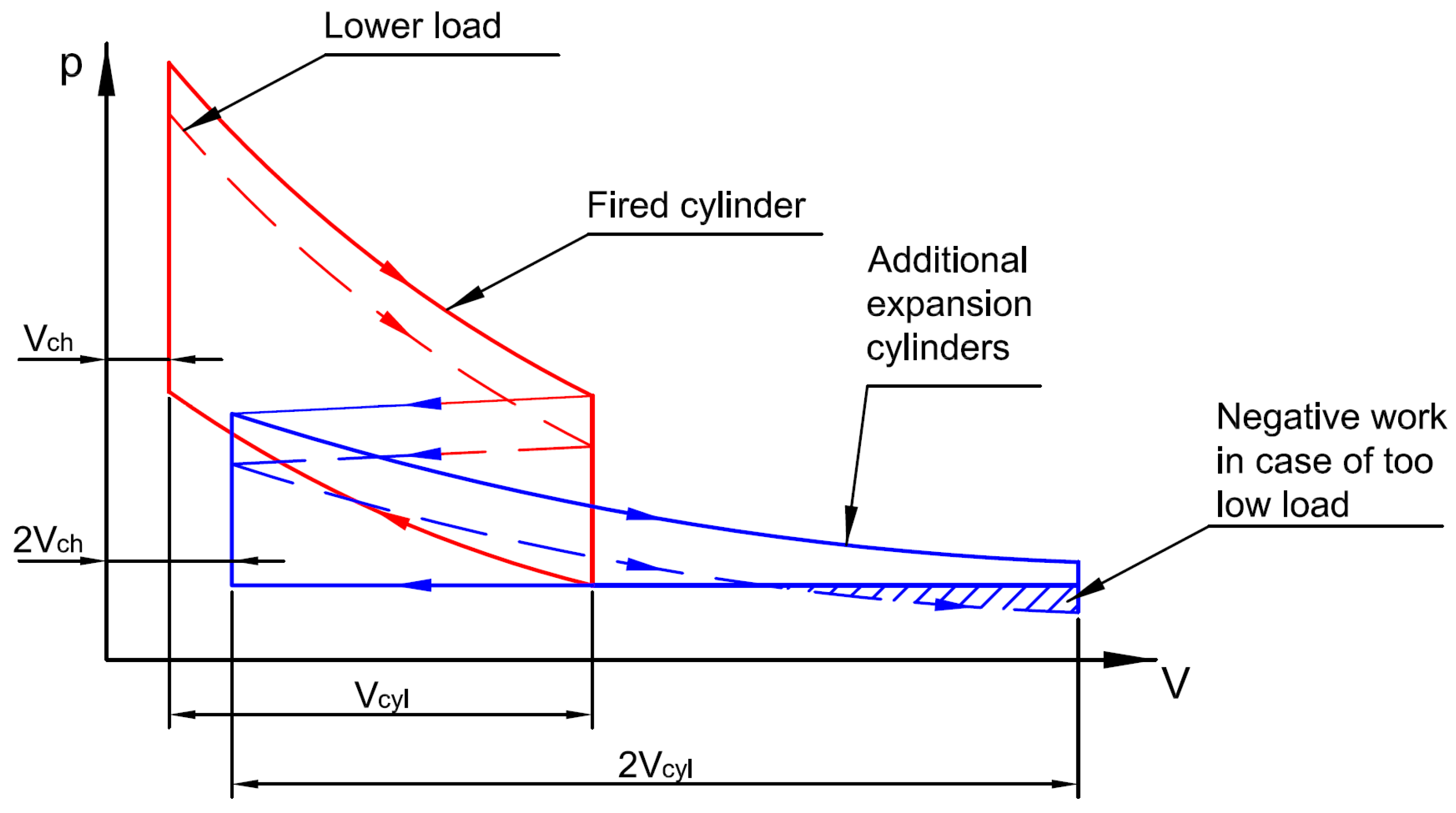


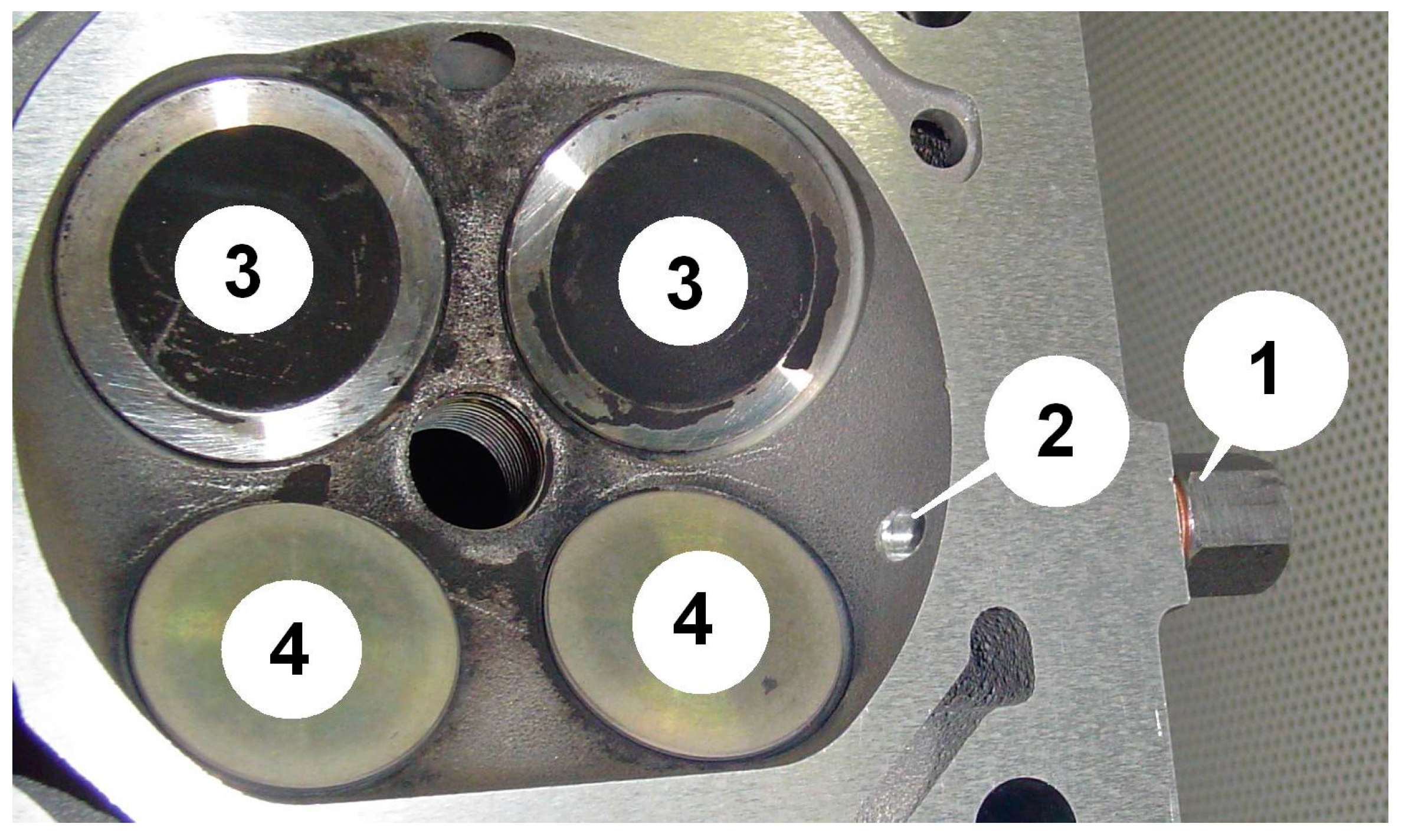
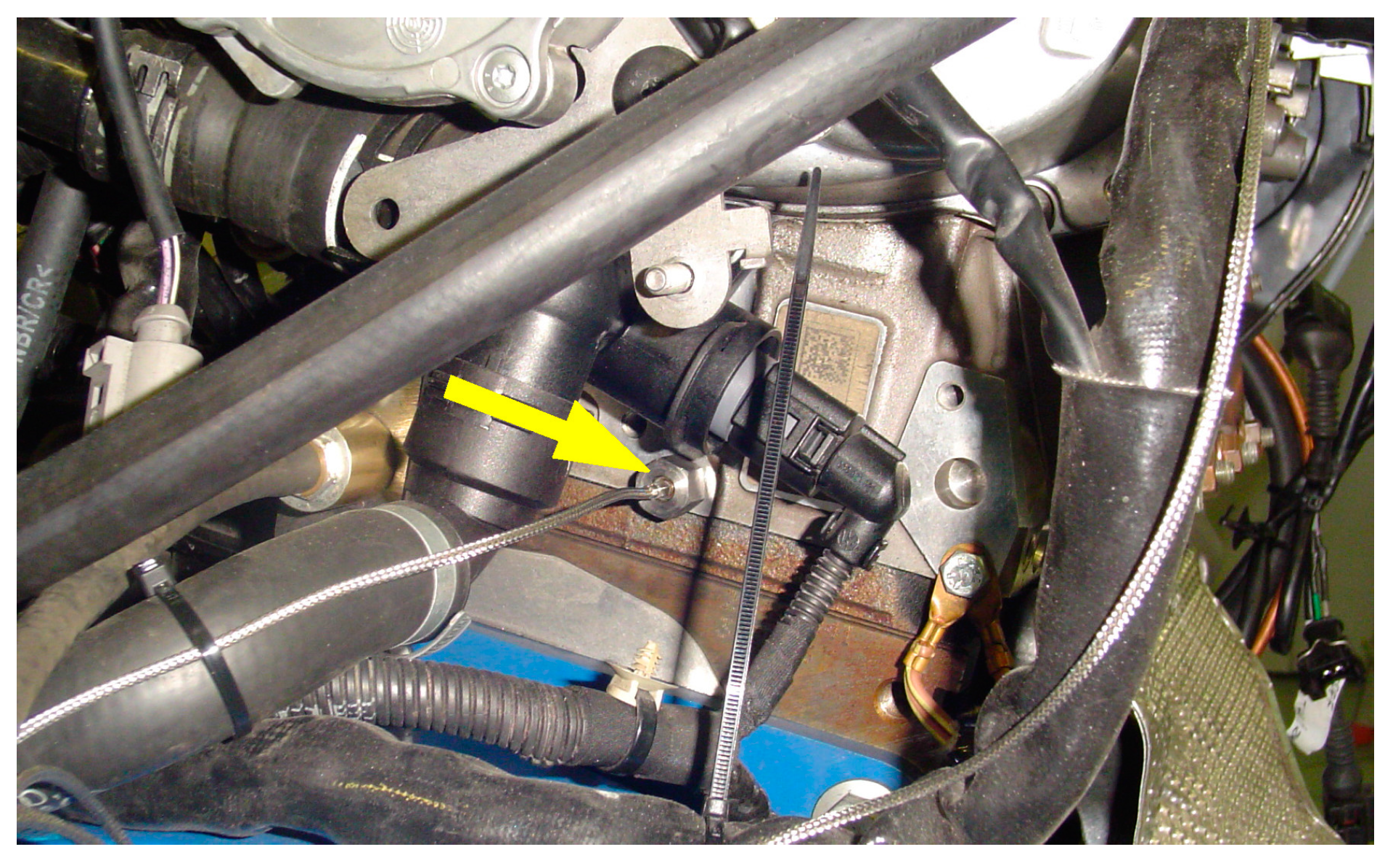



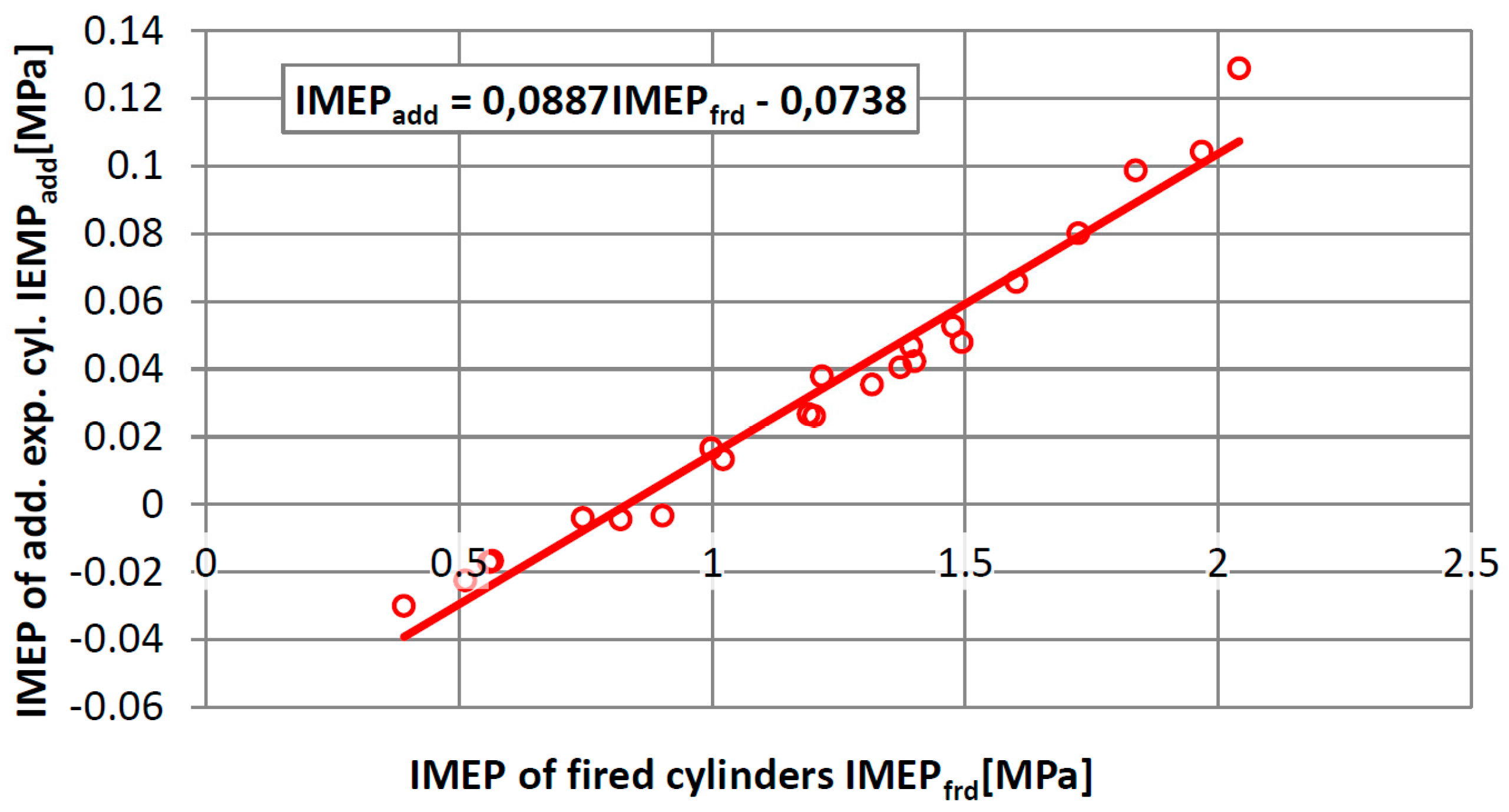
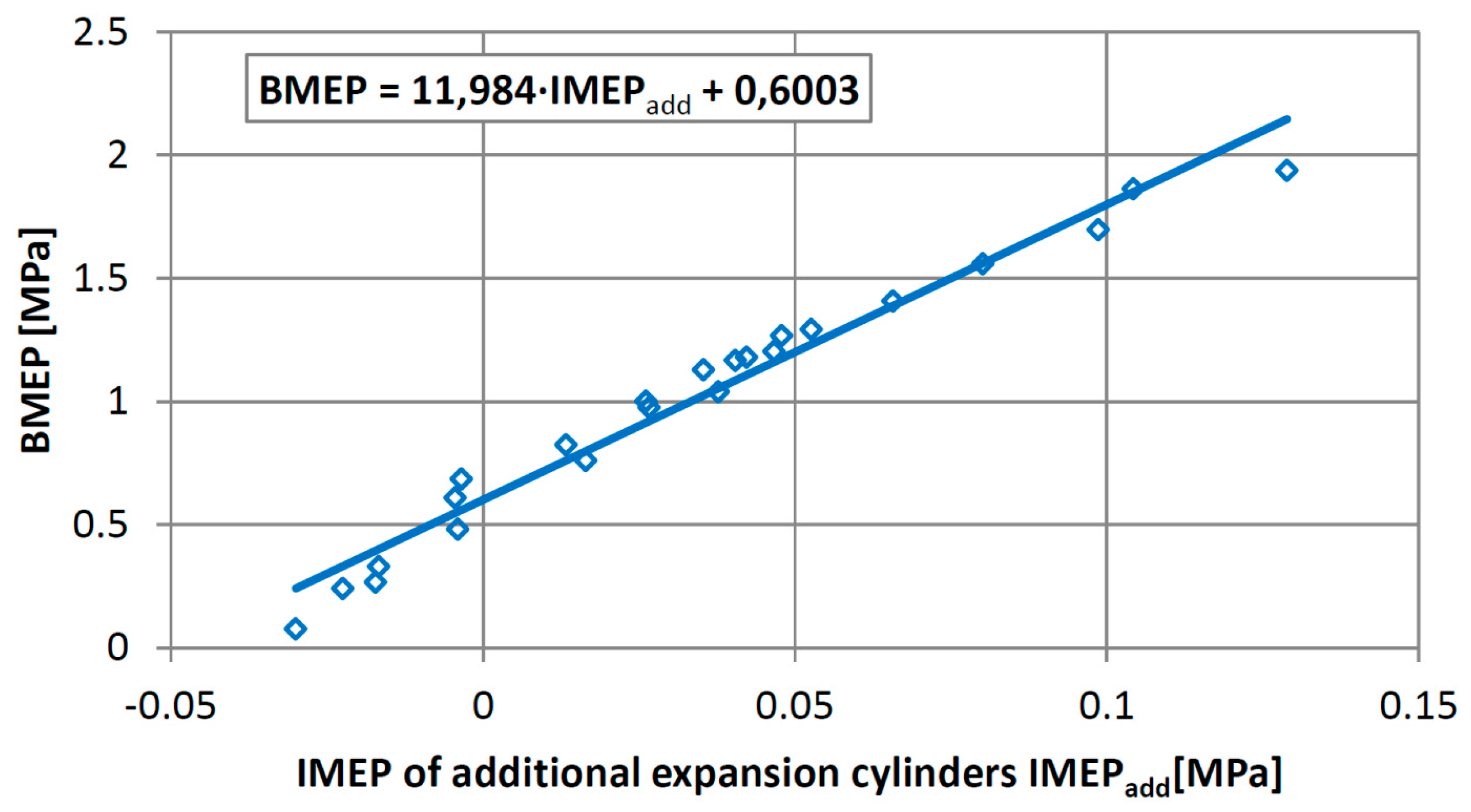
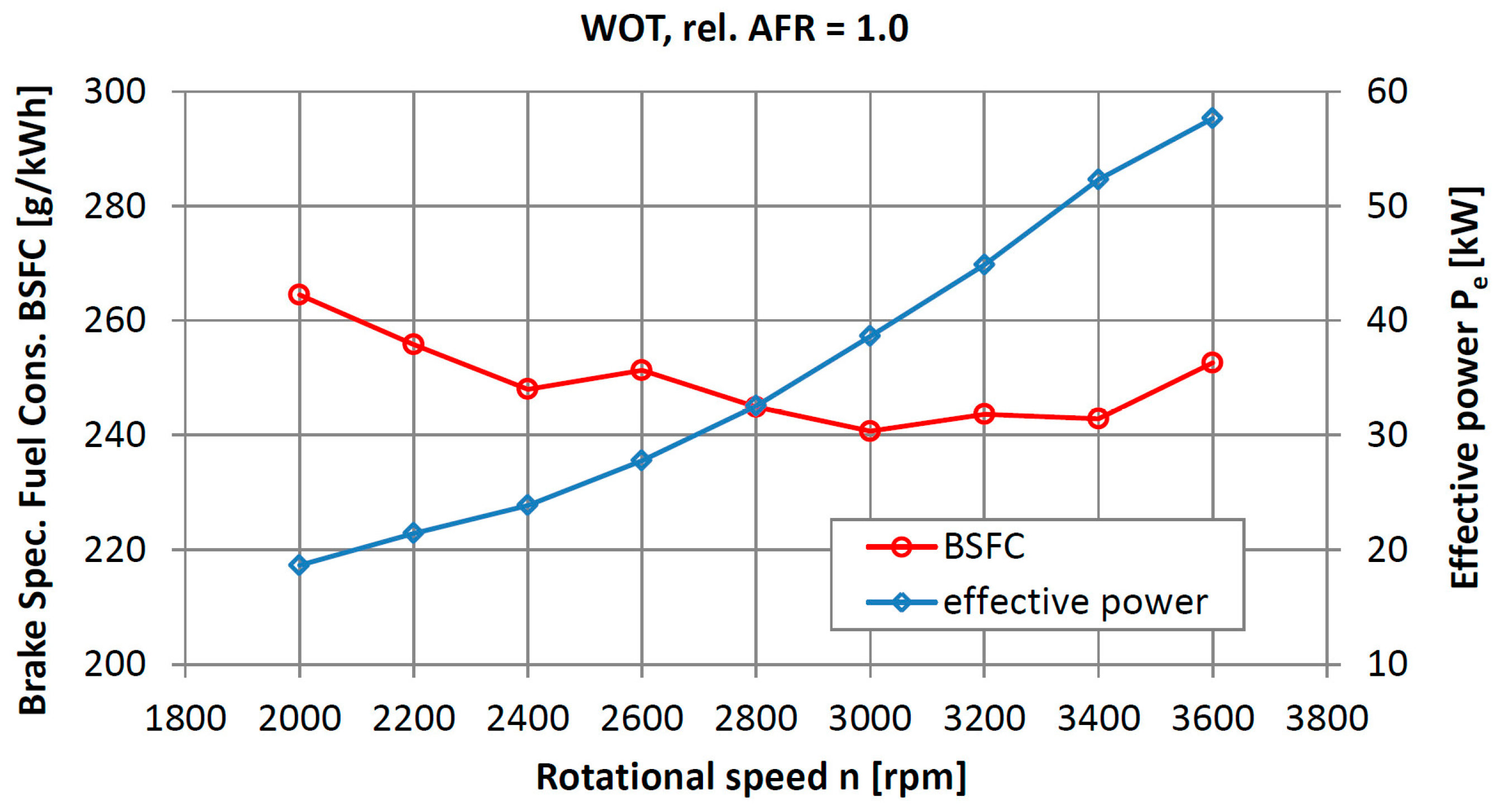
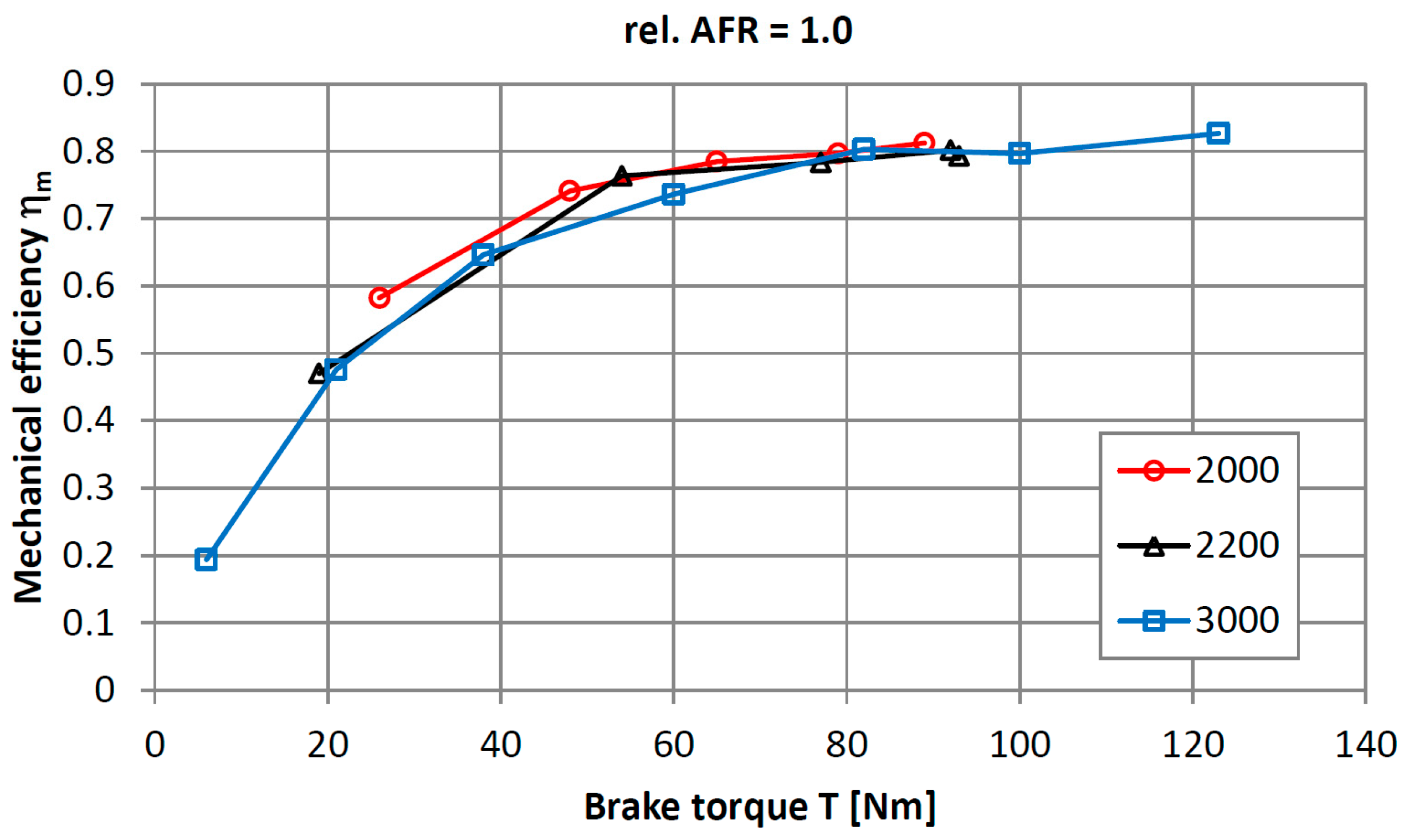
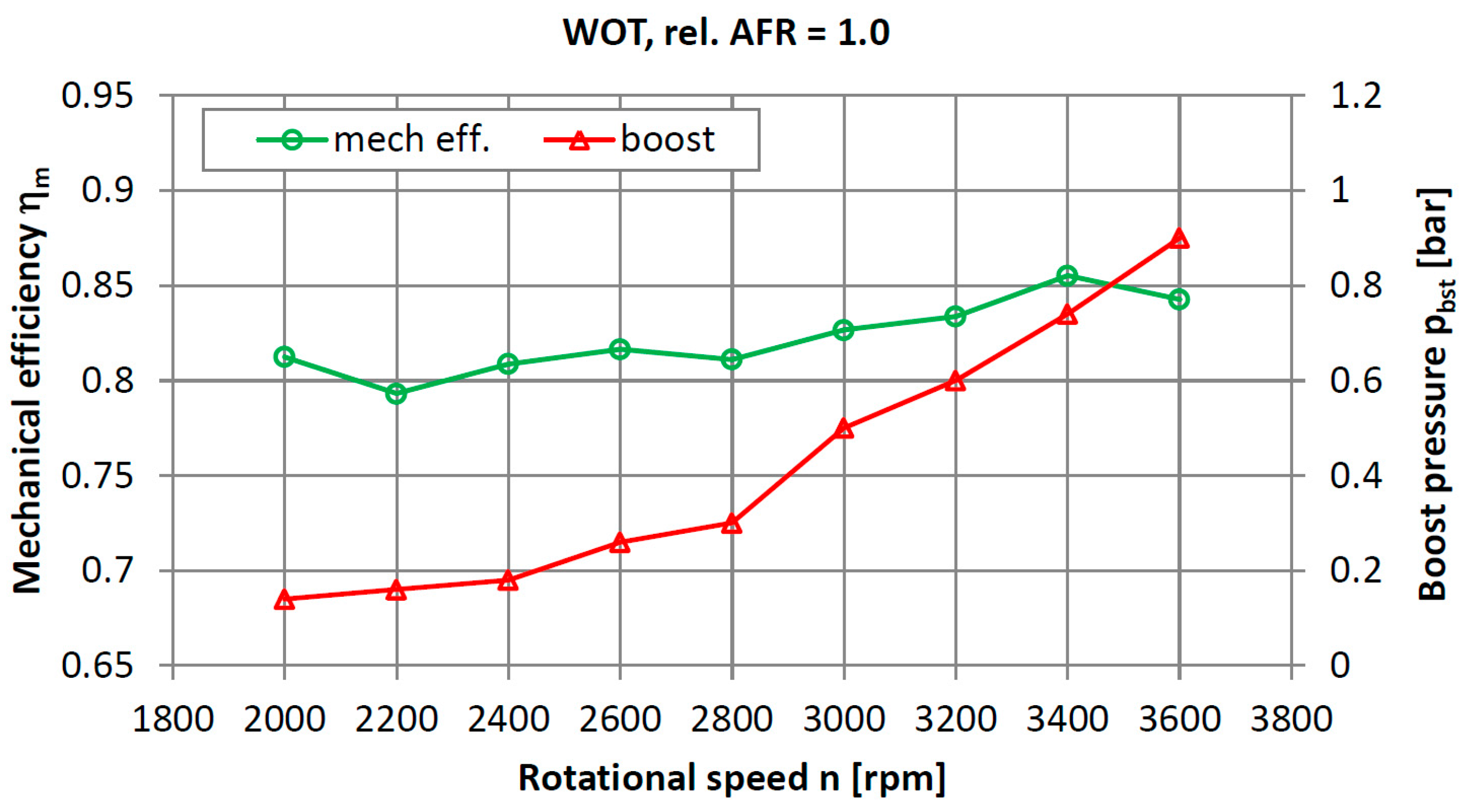
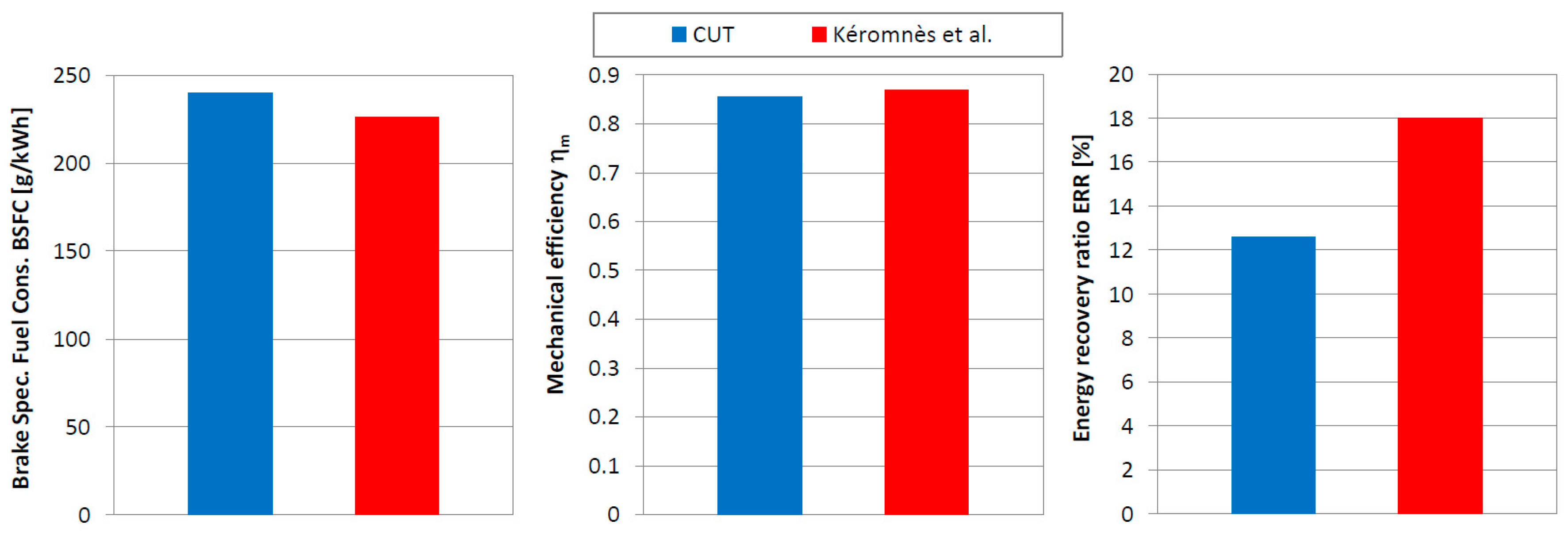
| Parameter | Value |
|---|---|
| Bore | 82.5 mm |
| Stroke | 92.8 mm |
| Compression ratio, εcp | 10.5 |
| No. of cylinders | 4 in-line, 2 fired and 2 add. expansion |
| Displacement of a fired cylinder, Vfrd | 2 cylinders, 496 cm3 each |
| Displacement of both add. expansion cylinders, Vadd | 992 cm3 |
| Overall expansion ratio εdcp | 21 |
| No. of valves | 4 per cylinder |
| Turbocharger type | KP39 |
| Control system | AEM EMS 30-1010 |
| High-pressure injector driver | Denso 131000-1041 |
| Control method of high-pressure of fuel | pressure relief valve |
© 2017 by the author. Licensee MDPI, Basel, Switzerland. This article is an open access article distributed under the terms and conditions of the Creative Commons Attribution (CC BY) license ( http://creativecommons.org/licenses/by/4.0/).
Share and Cite
Noga, M. Selected Issues of the Indicating Measurements in a Spark Ignition Engine with an Additional Expansion Process. Appl. Sci. 2017, 7, 295. https://doi.org/10.3390/app7030295
Noga M. Selected Issues of the Indicating Measurements in a Spark Ignition Engine with an Additional Expansion Process. Applied Sciences. 2017; 7(3):295. https://doi.org/10.3390/app7030295
Chicago/Turabian StyleNoga, Marcin. 2017. "Selected Issues of the Indicating Measurements in a Spark Ignition Engine with an Additional Expansion Process" Applied Sciences 7, no. 3: 295. https://doi.org/10.3390/app7030295





